The PE Coated Sack Kraft Paper Market is estimated to be valued at USD 5.5 billion in 2025 and is projected to reach USD 8.5 billion by 2035, registering a compound annual growth rate (CAGR) of 4.5% over the forecast period.
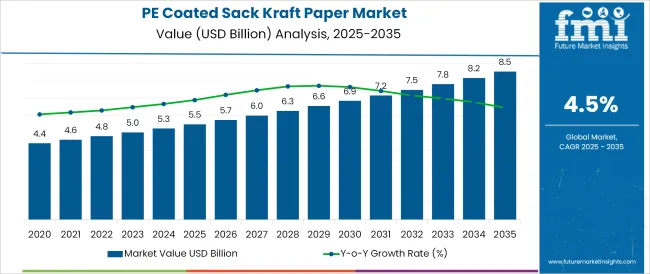
The PE coated sack kraft paper market is undergoing consistent transformation due to rising demand for sustainable yet durable packaging materials, particularly in industrial and bulk handling applications. Shifting regulatory mandates around plastic use and increased focus on eco-efficiency have steered manufacturers toward hybrid solutions like PE-coated paper, which offer strength, moisture resistance, and recyclability.
Advancements in extrusion coating technology and fiber optimization have enabled the development of sack kraft papers with improved tear resistance and superior sealing properties. This makes them highly suitable for heavy-duty uses such as cement, fertilizer, and construction material packaging.
Additionally, brand-conscious manufacturers in the food and chemical sectors are increasingly adopting these materials for better printability and product branding. The market outlook remains robust, driven by evolving end-user requirements, compliance with extended producer responsibility (EPR) norms, and increased investments in paper-based flexible packaging solutions globally.
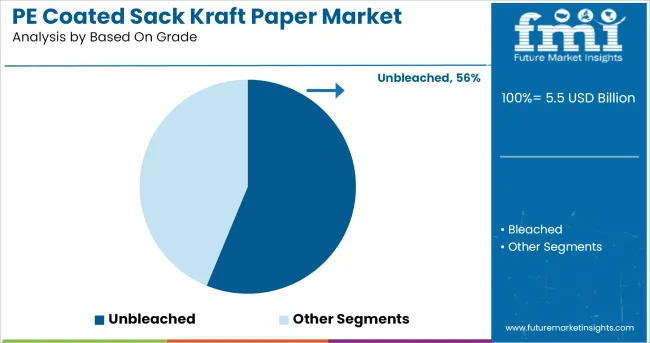
The unbleached segment is projected to hold 56.20% of total market revenue by 2025, making it the dominant grade category in the PE coated sack kraft paper market. This leadership is attributed to the superior mechanical strength and cost-efficiency of unbleached kraft, which is preferred in high-volume industrial packaging.
The lack of chemical bleaching results in higher fiber integrity, making it well-suited for heavy-duty sacks where durability and burst strength are critical. In addition, growing environmental preference for minimally processed materials has further reinforced the use of unbleached grades.
The visual appearance of natural brown paper is also being positively associated with eco-conscious branding, particularly in industrial and construction-related sectors. These attributes have enabled unbleached kraft to retain its prominence across a wide range of end-use applications.
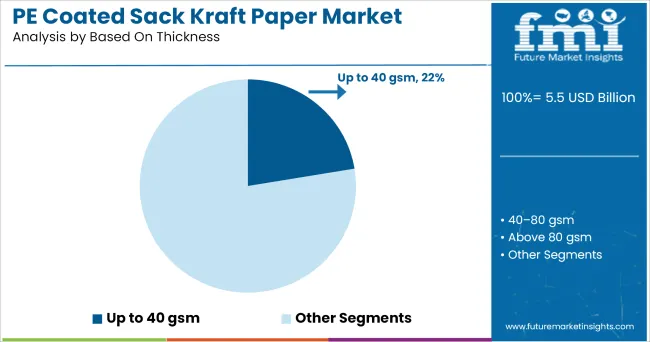
The segment comprising papers with up to 40 gsm thickness is expected to account for 22.40% of total market revenue in 2025. This lightweight variant is favored for specific packaging formats where weight reduction, cost-efficiency, and flexibility are prioritized.
Applications such as inner linings, protective layers, and secondary packaging have increasingly adopted lower gsm papers to reduce overall material consumption without compromising product safety. Furthermore, enhanced coating technologies have allowed even thinner papers to achieve high moisture resistance and sealability.
The adoption of up to 40 gsm grades is also being supported by e-commerce packaging needs and a growing demand for packaging solutions that balance sustainability with strength. As manufacturers optimize resource usage and pursue leaner packaging profiles, this sub-segment is expected to witness continued growth.

The industrial application segment is estimated to contribute 24.30% of the overall market revenue by 2025, positioning it as a key driver of demand. This growth is underpinned by the widespread use of PE coated sack kraft paper in heavy-duty applications such as cement, chemicals, and agricultural inputs.
Industries prioritize packaging materials that offer resistance to moisture, high tensile strength, and ease of palletization—features which are strongly delivered by PE-coated kraft papers. Moreover, the demand for dust-free, tamper-proof packaging in compliance with occupational safety standards has encouraged adoption in industrial environments.
The segment’s expansion is further supported by infrastructure development activities and increased export-oriented packaging where product integrity during transit is essential. Collectively, these factors have reinforced the industrial segment’s significant share within the broader PE coated sack kraft paper landscape.
Many fruits and vegetables are not only pressure-sensitive, but they must also remain fresh and intact even when wet. Salad, cucumber, and strawberry trays, for example, can withstand automatic washing tunnels thanks to an extra layer of Polyethene. As a result, PE coated sack kraft paper is gaining popularity around the world.
It also has homogeneous and seamless surfaces, making it ideal for high-quality offset printing. This paper has flexible problems and hence process such as cutting, creasing, grooving, folding is easy to perform. The primary trends in the packaging industry are expected to be sustainability and recyclability. The government of many countries' plastic regulatory norms have fueled the development of the PE coated sack kraft paper market.
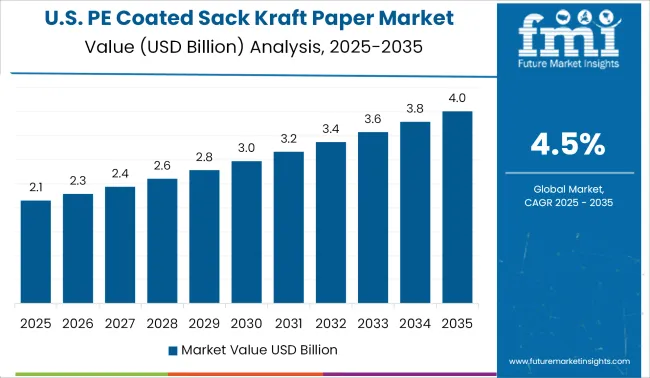
PE Coated Sack Kraft Paper are widely used in North American countries such as the United States and Canada in fast food chains. PE coated paper is coated with polyethene, creating a highly effective grease and moisture obstacle.
PE coated sack kraft paper, could be used for hot applications as it would not melt and disturb food items. PE coated sack kraft paper is also ideally suited for packaging hot, greasy foods, as well as in-tray liner in fast food joints, hence there is increasing use of PE coated sack kraft paper in the region.
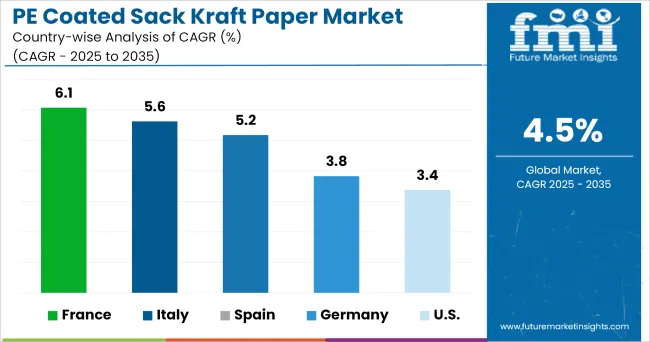
Europe is one of the key markets for PE coated sack kraft paper. The Europe PE coated sack kraft paper market is all set to observe a notable growth rate during the assessment period 2024 to 2035.
Usage for PE coated sack kraft paper has amplified in Europe as construction activity has increased, as has awareness of eco-friendliness. Durable packaging has aided the market's recovery. For example, demand for PE Coated sack kraft paper in Germany surpassed supply in 2020, due to factors such as new customer orders or extended amounts exceeding existing contracts.
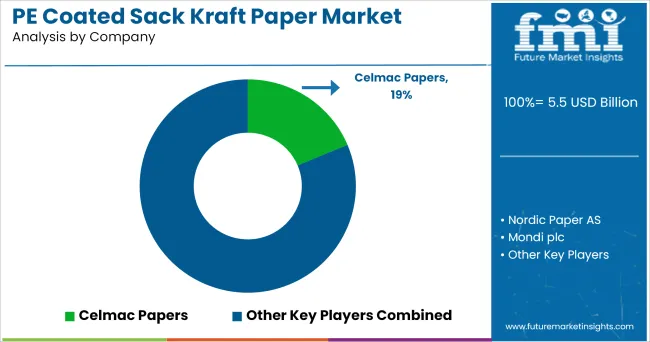
Some key manufacturers functioning in business in PE coated sack kraft paper market includes
The report is a compilation of first-hand information, qualitative and quantitative assessment by industry analysts, inputs from industry experts and industry participants across the value chain. The report provides an in-depth analysis of parent market trends, macro-economic indicators and governing factors along with market attractiveness as per segments. The report also maps the qualitative impact of various market factors on market segments and geographies.
The global PE coated sack kraft paper market is estimated to be valued at USD 5.5 billion in 2025.
The market size for the PE coated sack kraft paper market is projected to reach USD 8.5 billion by 2035.
The PE coated sack kraft paper market is expected to grow at a 4.5% CAGR between 2025 and 2035.
The key product types in PE coated sack kraft paper market are unbleached and bleached.
In terms of based on thickness, up to 40 gsm segment to command 22.4% share in the PE coated sack kraft paper market in 2025.






Full Research Suite comprises of:
Market outlook & trends analysis
Interviews & case studies
Strategic recommendations
Vendor profiles & capabilities analysis
5-year forecasts
8 regions and 60+ country-level data splits
Market segment data splits
12 months of continuous data updates
DELIVERED AS:
PDF EXCEL ONLINE
Market Share Insights of PE Coated Sack Kraft Paper Providers
Coated Sack Kraft Paper Market
Pet Tick and Flea Prevention Market Forecast and Outlook 2025 to 2035
Pet Hotel Market Forecast and Outlook 2025 to 2035
PET Vascular Prosthesis Market Size and Share Forecast Outlook 2025 to 2035
Pet Food Preservative Market Forecast and Outlook 2025 to 2035
Performance Elastomer Market Size and Share Forecast Outlook 2025 to 2035
Perfume Packs Market Size and Share Forecast Outlook 2025 to 2035
Personal Care Ingredient Market Size and Share Forecast Outlook 2025 to 2035
Pectin Industry Analysis in Japan Size and Share Forecast Outlook 2025 to 2035
Pea Grits Market Size and Share Forecast Outlook 2025 to 2035
Petroleum Liquid Feedstock Market Size and Share Forecast Outlook 2025 to 2035
Pet Food Ingredients Market Size and Share Forecast Outlook 2025 to 2035
Perfluoroelastomer Market Size and Share Forecast Outlook 2025 to 2035
PET Stretch Blow Molding Machines Market Size and Share Forecast Outlook 2025 to 2035
PET Injectors Market Size and Share Forecast Outlook 2025 to 2035
Pediatric Measuring Devices Market Size and Share Forecast Outlook 2025 to 2035
Peelable Lid Stock Market Size and Share Forecast Outlook 2025 to 2035
Personal Protective Equipment Market Size and Share Forecast Outlook 2025 to 2035
Personality Assessment Solution Market Size and Share Forecast Outlook 2025 to 2035

Thank you!
You will receive an email from our Business Development Manager. Please be sure to check your SPAM/JUNK folder too.
Chat With
MaRIA